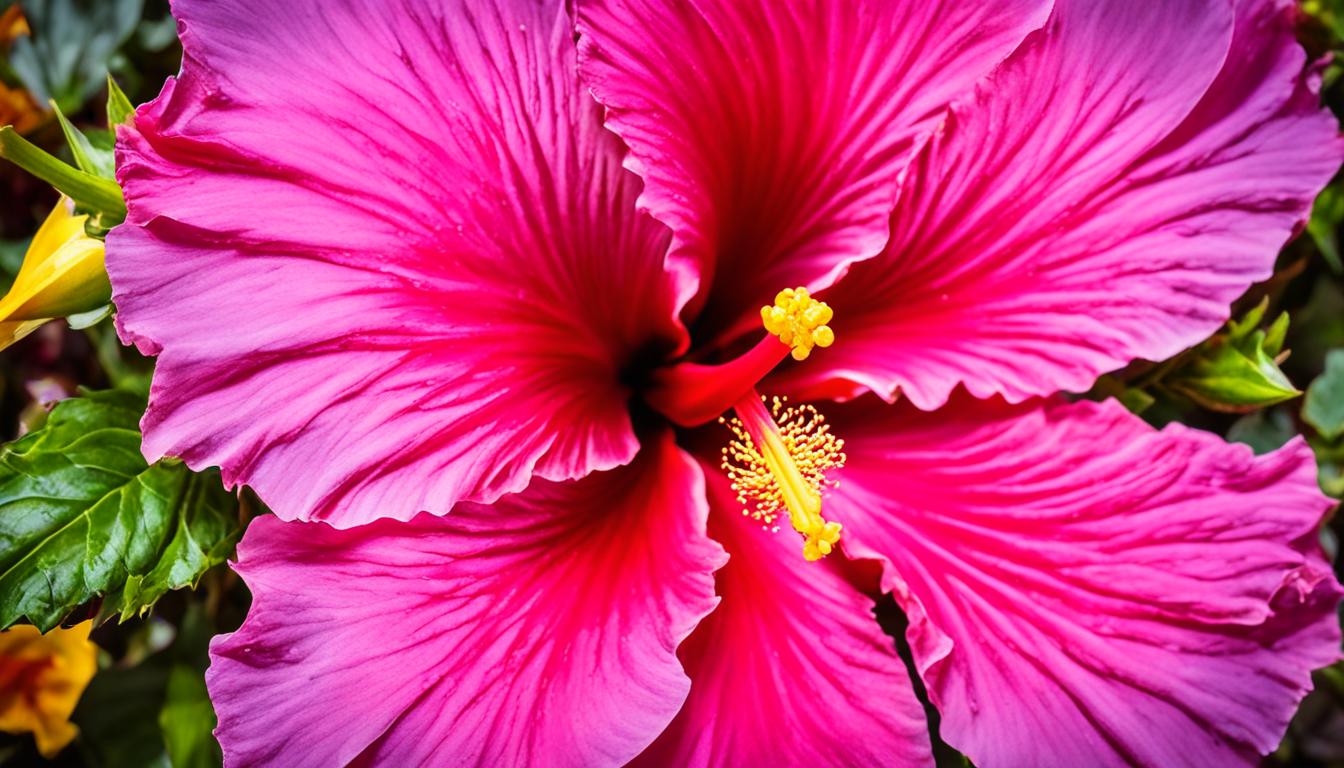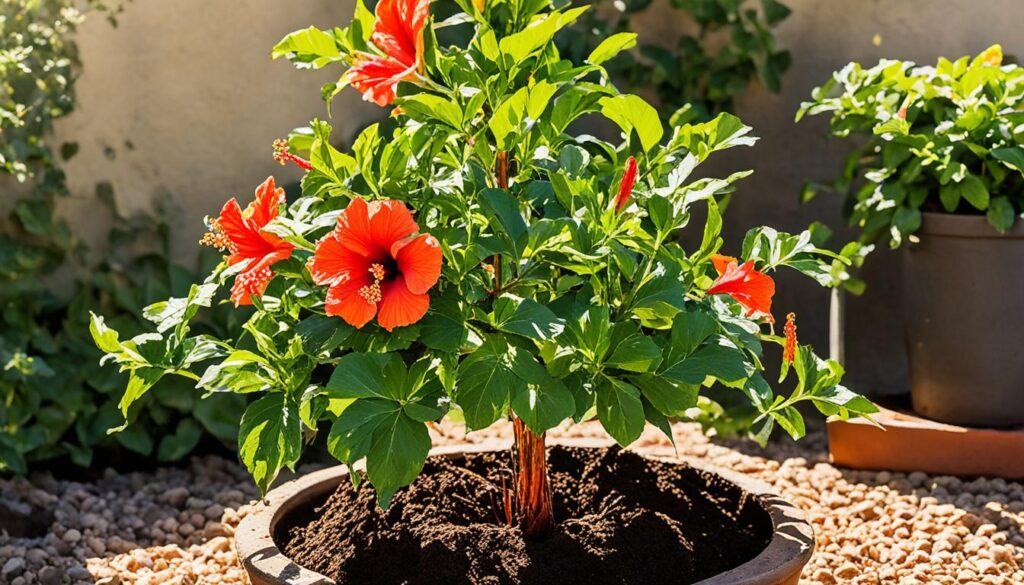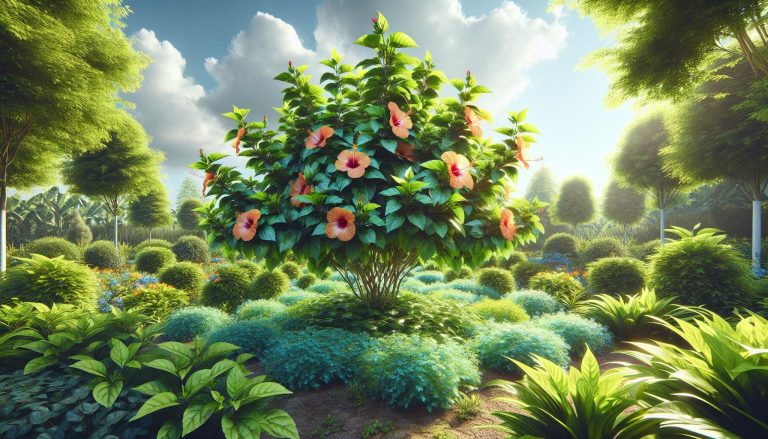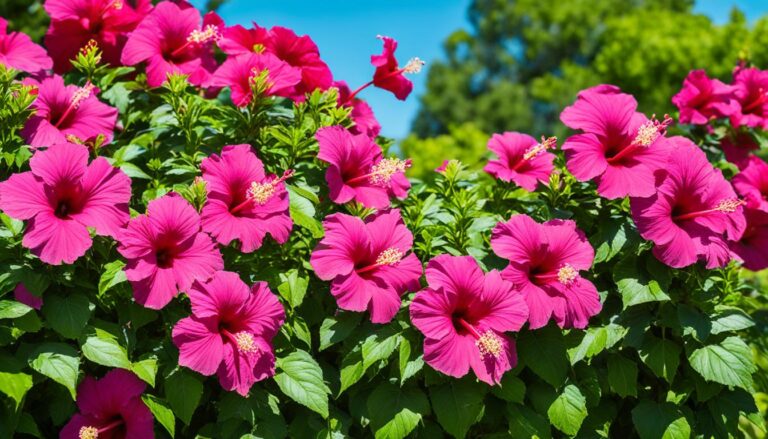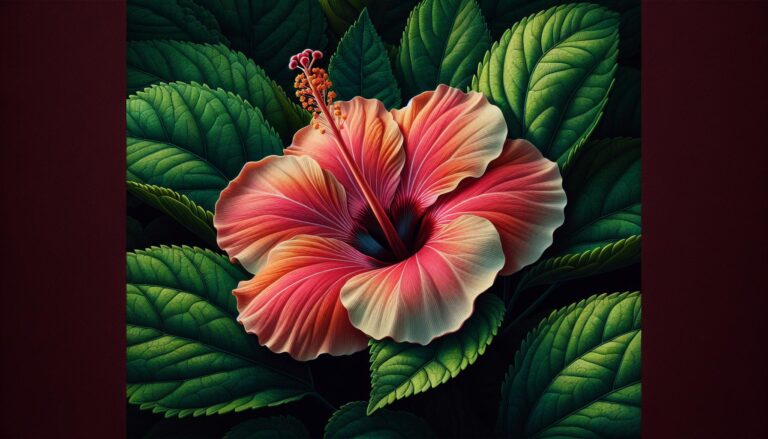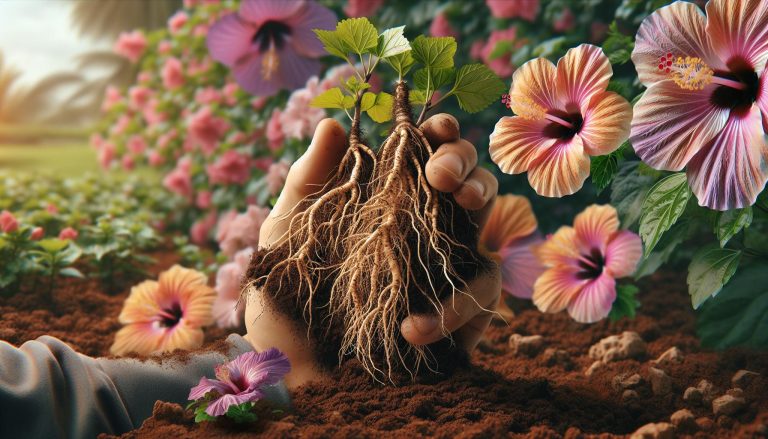California Hibiscus Care Tips & Varieties
Imagine strolling through a lush California garden, the vibrant blooms of hibiscus plants catching your eye at every turn. The sight of these stunning flowers brings a sense of joy and tranquility. Whether you’re an experienced gardener or just starting your horticultural journey, hibiscus plants are a perfect choice for adding beauty and color to your outdoor oasis.
Known for their ability to thrive in California’s drought-tolerant conditions, hibiscus plants have become a beloved staple in gardens throughout the Golden State. From their show-stopping blooms to their resilience in hot and dry climates, these native beauties have captured the hearts of gardeners far and wide.
In this article, we will explore essential care tips for growing hibiscus in California and delve into the captivating varieties that will inspire your landscape. Whether you’re dreaming of a hibiscus-filled paradise or looking for ways to enhance your existing garden, this guide will provide you with the knowledge and inspiration you need to create a thriving hibiscus haven.
Key Takeaways:
- California hibiscus is a popular choice for gardeners due to its vibrant blooms and ability to thrive in drought-tolerant conditions.
- Understanding hibiscus soil and pot selection is crucial for successful growth.
- Feeding hibiscus plants with the right nutrients is essential for optimal health and blooming.
- Watering hibiscus plants requires finding the right balance and adjusting to weather conditions.
- Protecting hibiscus plants from excessive heat is crucial for maintaining their health and vigor.
Understanding Hibiscus Soil and Pot Selection
For the successful growth of California hibiscus, it is crucial to pay attention to the soil and pot selection. The right soil and pot can provide the necessary conditions for your hibiscus plants to thrive and bloom beautifully.
When it comes to hibiscus soil, opt for a mixture that is light, fluffy, and provides ample air circulation. This ensures that the roots receive enough oxygen and prevents issues such as root rot. A well-draining soil is key to maintaining the health of your hibiscus.
For optimal drainage, consider using a potting mix that contains perlite and/or pumice. These additives help create air pockets in the soil, allowing excess water to escape and preventing waterlogged conditions that can lead to root rot. Avoid using soil mixes that contain composted materials and worm castings, as they can make the soil heavy and retain too much moisture.
When selecting a pot for your hibiscus, choose one with sufficient drainage holes to allow excess water to escape. Check the pot regularly for any root blockage that may occur over time. Additionally, avoid packing the soil tightly in the pot, as this can hinder proper drainage.
It is also worth noting that adding a layer of rocks at the bottom of the pot, often referred to as a “rock layer,” does not improve drainage and may actually impede it. Instead, focus on using a well-draining soil mix and a pot with proper drainage holes.
By understanding the importance of selecting the right soil and pot for your hibiscus plants, you can create the ideal conditions for their growth and ensure their long-term health.+
Feeding California Hibiscus Plants
Hibiscus plants, especially those grown in California, have specific nutrient requirements to ensure optimal growth and vibrant blooms. These plants thrive when provided with the right balance of essential elements. Understanding their nutrient needs is crucial for hibiscus enthusiasts to achieve gardening success.
The Essential Nutrients for Hibiscus Plants
When it comes to feeding hibiscus plants, it is important to consider their specific nutrient requirements:
- Potassium: Hibiscus plants have a high demand for potassium, which is essential for flower formation and overall plant health.
- Phosphorus: While hibiscus plants require phosphorus for root development, they need lower levels of this nutrient compared to potassium.
- Nitrogen: Hibiscus plants have a moderate to low requirement for nitrogen, and this need tends to decrease in hotter climates.
It’s worth noting that many common plant fertilizers have the opposite nutrient ratios of what hibiscus plants need. Using these fertilizers may result in nutrient imbalances and hinder plant growth.
Specialized Fertilizers for Hibiscus Plants
To meet the unique nutrient needs of hibiscus plants, it is recommended to use specialized fertilizers. Two popular options are:
- Hidden Valley Hibiscus Special Blend: This fertilizer has been specifically formulated to provide hibiscus plants with the right balance of nutrients, including potassium, phosphorus, and nitrogen.
- Palm Tree Fertilizer: While not designed exclusively for hibiscus plants, palm tree fertilizers often contain the necessary nutrients, making them a suitable alternative.
Both of these fertilizers ensure that hibiscus plants receive the proper nutrition they need for healthy growth and abundant flowering. They can be easily found at garden centers or online retailers.
Feeding Schedule and Application
When applying fertilizer to hibiscus plants, it is essential to follow the instructions provided by the manufacturer. Typically, fertilization should occur every 4-6 weeks during the growing season, which is typically spring through fall. However, it’s important to adjust the frequency based on soil conditions and the plant’s response.
| Fertilizer | Application Rate | Frequency |
|---|---|---|
| Hidden Valley Hibiscus Special Blend | As directed by the manufacturer | Every 4-6 weeks during the growing season |
| Palm Tree Fertilizer | As directed by the manufacturer | Every 4-6 weeks during the growing season |
Remember to water the plants thoroughly after applying fertilizer to ensure proper nutrient uptake.
By understanding the nutrient requirements of hibiscus plants and using specialized fertilizers, California hibiscus enthusiasts can provide their plants with the essential elements needed for vibrant blooms and healthy growth.
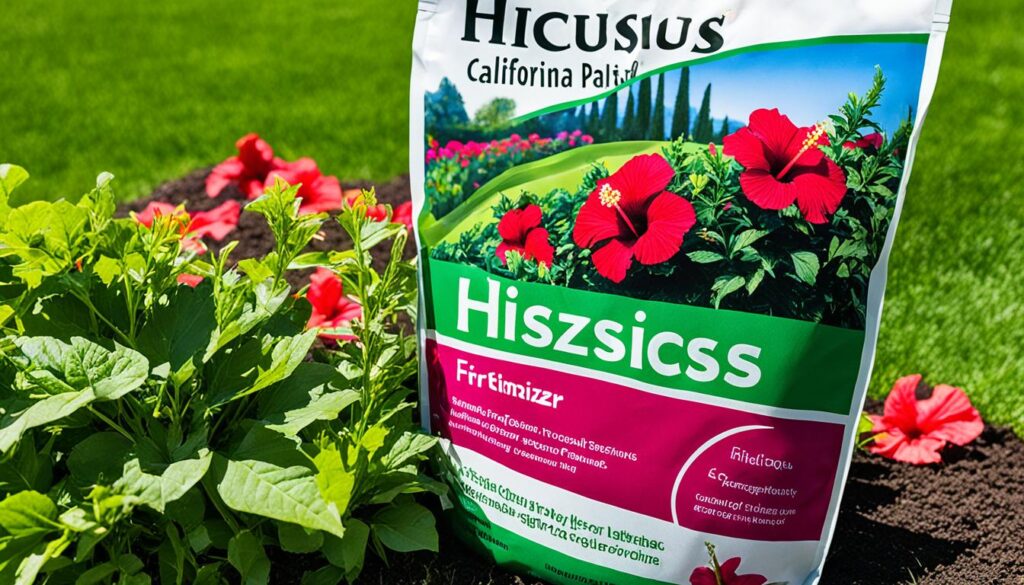
Watering California Hibiscus: Finding the Balance
Proper watering is essential for the health of your California hibiscus plants. Overwatering can lead to root rot and stress, while underwatering can cause pale and veiny leaves. To find the right balance, it’s important to consider several factors and adjust your watering routine accordingly.
Check Moisture Levels
Before watering your hibiscus, it’s crucial to check the moisture level of the soil. While the top layer may appear dry, the water content deep down can be saturated. To ensure accurate assessment, use a water meter to gauge the moisture level at different depths.
Consider Pot Size, Climate, and Plant Needs
The frequency of watering depends on various factors, including the size of the pot, climate conditions, and the specific needs of your hibiscus plant. Smaller pots tend to dry out faster and may require more frequent watering. In hot and dry climates, you may need to water more often to combat heatwaves. Adjust your watering routine based on these considerations to keep your hibiscus healthy and well-hydrated.
Adapt to Seasonal Changes
Watering during winter requires special consideration for hibiscus plants. In colder months, hibiscus may require less frequent watering, and in some cases, no watering at all. Evaluate the moisture level of the soil and adjust your watering routine accordingly based on the specific needs of your hibiscus plants during winter.
Reduce Fertilization in High Temperatures
During periods of high temperatures or heatwaves, it’s important to reduce fertilization for your hibiscus plants. High temperatures can increase stress on the plant, and reducing fertilization helps alleviate this stress. It’s crucial to allow your hibiscus plants to focus on maintaining essential functions and withstand the heat.
Remember to always find the right balance when watering your California hibiscus plants. By adjusting your watering routine based on moisture levels, pot size, climate, and the specific needs of your plants, you can help them thrive and bloom beautifully.
Navigating California Heat: Protecting Your Hibiscus
While hibiscus plants are known for their tropical origins and vibrant blooms, they can be sensitive to sudden heatwaves and fluctuating temperatures. California’s climate, with its hot summers, can pose challenges for hibiscus care. Understanding the heat tolerance of these plants and implementing proper temperature adjustment techniques can help protect your hibiscus and ensure their continued growth and vitality.
Hibiscus Heat Tolerance
Hibiscus plants have a moderate heat tolerance but can struggle in extreme heat conditions. When exposed to temperatures over 95°F, hibiscus plants can experience stress, resulting in leaf shedding and bud drop. To prevent heat-induced damage, it is important to provide adequate protection and care during hot weather.
Temperature Adjustment
For hibiscus plants grown in non-tropical regions like California, gradual temperature adjustment is recommended. Sudden changes in temperature can shock the plants and hinder their growth. When moving hibiscus plants from indoor to outdoor environments or vice versa, gradually expose them to the new temperature conditions over a period of 1-2 weeks. This gradual adjustment helps the plants acclimate to the new surroundings and minimize temperature-related stress.
Shading
Providing shade for hibiscus plants during peak heat hours can offer protection and help regulate temperature. Utilize natural shade from trees or use shade cloths to create a temporary shelter for your hibiscus plants. Ensure the shading does not completely block out sunlight, as hibiscus plants require ample sunlight for healthy growth and blooming.
Leaf Shedding and Leggy Growth
Excessive heat can lead to leaf shedding and leggy growth in hibiscus plants. If you notice your hibiscus shedding leaves, it may be an indication that the plant is experiencing heat stress. To alleviate this issue, provide additional shade, increase watering frequency, and consider misting the leaves to create a more humid environment. Pruning leggy growth can also help redirect the plant’s energy and encourage bushier growth.
Reduced Fertilizer Use
During periods of hot weather, hibiscus plants experience an increase in metabolic rate and water uptake. This increased activity reduces the need for fertilization, as the plant’s energy is primarily focused on surviving the heat. Reduce the frequency and concentration of fertilizers during hotter months to avoid overstimulating the plant.
Spider Mite Population Increase
High temperatures, especially above 90°F, can trigger a significant increase in spider mite reproductive cycles. These pests can quickly infest hibiscus plants, causing damage and hindering growth. Regularly inspect your hibiscus plants for signs of spider mites, such as webbing and discoloration. If an infestation is detected, employ appropriate pest control measures, such as the use of organic insecticidal soaps or natural predators like ladybugs.
Transitioning Indoors: Be Mindful of Acclimation
Moving hibiscus plants indoors during colder months requires gradual acclimation to the new environment. Sudden changes in temperature and humidity can stress the plants and negatively impact their growth. It is recommended to transition hibiscus plants indoors over a period of 2-3 weeks to allow them to adjust slowly.
One important aspect to consider during this transition is maintaining adequate humidity levels. Indoor heating can lead to dry air, which hibiscus plants from tropical regions are not suited for. Ensuring sufficient humidity is crucial to keep your hibiscus healthy and thriving indoors during the winter months.
In addition to humidity, it may be beneficial to provide extra light to your indoor hibiscus plants. Grow lights can help supplement the natural light they receive and ensure they continue to thrive indoors. Creating optimal conditions for your hibiscus plants will help them maintain their vibrant blooms and lush foliage throughout the winter season.
When transitioning your hibiscus indoors, be cautious of general gardening advice that may not specifically address the needs of hibiscus plants. Each plant has unique care requirements, and it’s essential to tailor your approach accordingly. Follow indoor growing tips for hibiscus to ensure they receive the ideal care they need during the colder months.
By taking the time to acclimate your hibiscus plants, maintaining proper humidity levels, providing adequate light, and being mindful of their specific needs, you can successfully transition them indoors and enjoy their beauty throughout the winter season.
Common Mistakes to Avoid When Growing Hibiscus
When it comes to hibiscus care, it’s important to understand that these plants have unique growing requirements that differ from other flowering plants. Many experienced gardeners make the mistake of assuming that hibiscus will thrive under the same conditions as their other plants. To ensure the health and growth of your hibiscus, it’s essential to be observant, patient, and embrace your inner “plant detective”. Avoiding common mistakes like overwatering, misidentifying nutrient deficiencies, and using clay pots can greatly enhance the success of your hibiscus garden.
Observant Gardening
Observant gardening is key when it comes to caring for hibiscus plants. Pay close attention to the condition of your plants, keeping an eye out for any changes or signs of stress. Be observant of leaf color, wilting, and unusual growth patterns. By promptly addressing any issues, you can prevent further damage and promote healthy growth.
Patience is Essential
Patience is a virtue when it comes to hibiscus care. These plants may take some time to establish and reach their full potential. It’s important to avoid rushing the process and give your hibiscus the time it needs to adapt to its environment and grow strong roots. With patience, you will be rewarded with vibrant blooms and healthy foliage.
Avoid Watering Mistakes
One of the most common mistakes in hibiscus care is overwatering. While it’s important to keep your plants hydrated, excessive watering can lead to waterlogged soil and root rot. Instead, water your hibiscus plants deeply but infrequently, allowing the soil to dry out slightly between waterings. This will encourage healthy root growth and prevent water-related issues.
Identify Nutrient Deficiencies
Proper nutrition is vital for the health of your hibiscus plants. Nutrient deficiencies can impact their growth and flower production. It’s important to be able to identify common nutrient deficiencies, such as yellowing leaves and stunted growth, and address them promptly with appropriate fertilizers or amendments. Regular soil testing can help you pinpoint any nutrient imbalances.
Avoid Clay Pots
While clay pots may be visually appealing, they can pose challenges for hibiscus care. Clay pots tend to retain moisture and may not provide adequate drainage, leading to root rot and other issues. It’s best to opt for plastic or stone pots that offer better drainage and moisture control, ensuring the health of your hibiscus plants.
By avoiding these common mistakes and taking a thoughtful and observant approach to hibiscus gardening, you can create an environment where your hibiscus plants thrive. Remember, hibiscus care requires unique considerations, and by being attentive to their needs, you’ll be rewarded with beautiful blooms and healthy, vibrant plants.
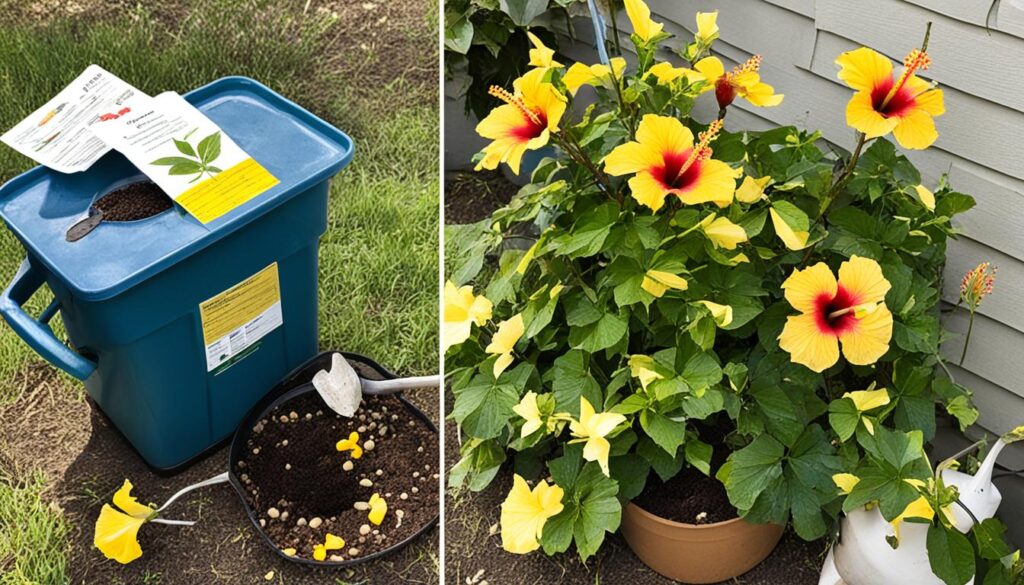
Exploring Hibiscus Varieties: From China to California
California hibiscus enthusiasts have the opportunity to explore a wide range of hibiscus species, each with its own unique characteristics and beauty. Let’s take a look at some of the hibiscus varieties that thrive in the California climate.
Hibiscus syriacus, also known as rose of sharon, is a small shrub native to China. With its stunning trumpet-shaped flowers in various colors, including shades of pink, purple, and white, hibiscus syriacus adds elegance and charm to any garden in California.
Hibiscus rosa-sinensis, commonly known as Chinese hibiscus, showcases vibrant, tropical blooms. While it requires winter protection in California’s cooler regions, this hibiscus species rewards gardeners with its show-stopping flowers in shades of red, orange, yellow, and pink.
If you’re looking for a cold-hardy hibiscus option, consider hibiscus moscheutos, also known as rose mallow or swamp rose mallow. This hardy hibiscus variety can withstand colder temperatures, making it an ideal choice for California’s diverse climates. Available in an array of colors, including white, pink, and red, hibiscus moscheutos adds a touch of whimsy and beauty to any landscape.
No matter which hibiscus species you choose, these stunning plants are sure to enhance the beauty of your California garden with their vibrant colors and unique flowers.
Comparison of Hibiscus Varieties
| Hibiscus Species | Common Name | Native Origin | Climate Requirements | Flower Colors |
|---|---|---|---|---|
| Hibiscus syriacus | Rose of Sharon | China | Well-suited to California | Pink, purple, white |
| Hibiscus rosa-sinensis | Chinese Hibiscus | Tropical regions | Requires winter protection | Red, orange, yellow, pink |
| Hibiscus moscheutos | Rose Mallow, Swamp Rose Mallow | North America | Cold-hardy | White, pink, red |
As you can see from the table, each hibiscus species offers its own unique characteristics and requirements. Consider the climate and growing conditions in your specific area of California when selecting the perfect hibiscus variety for your garden.
California-Specific Hibiscus Variety: The Holy Grail
In California, gardeners have the opportunity to grow a special and unique hibiscus variety known as the Holy Grail. This cold-hardy hibiscus is a true treasure for any garden, with its stunning bright red blooms that span an impressive 9 inches in diameter. The Holy Grail hibiscus features luscious deep green foliage that provides a striking contrast to its vibrant blossoms.
What sets the Holy Grail hibiscus apart is its ability to withstand low temperatures, making it a reliable perennial in California. This variety diligently overwinters, coming back year after year to grace your garden with its magnificent presence. While it may bloom a bit later in the season, the wait is well worth it when you witness the beauty this hibiscus brings to your outdoor space.
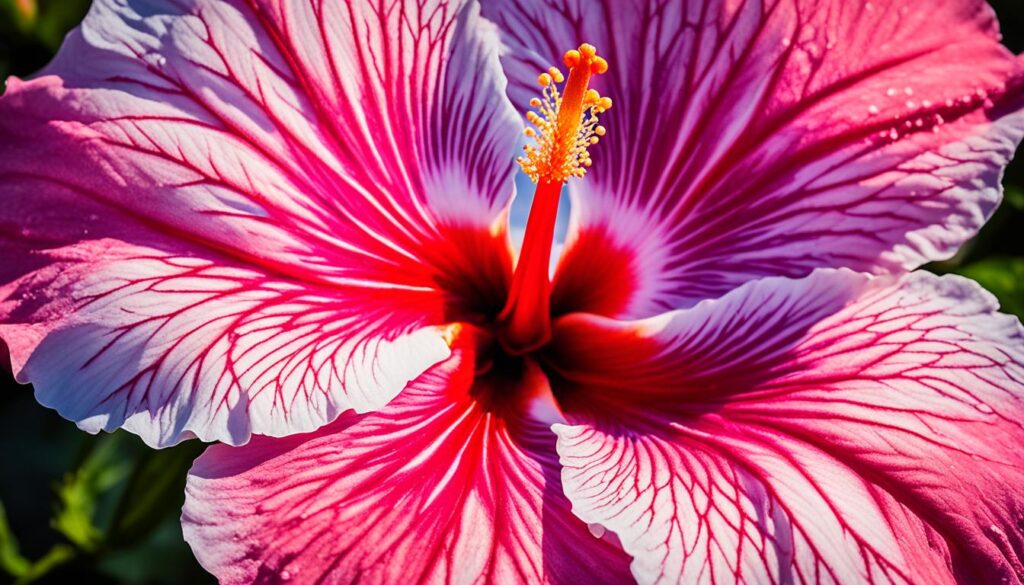
The Holy Grail hibiscus – a cold-hardy variety with bright red blooms.
| Key Features | Benefits |
|---|---|
| Cold-hardy | Thrives in low temperatures |
| Bright red blooms | Adds a pop of vibrant color to your garden |
| Perennial | Comes back year after year |
| Overwinters successfully | Can withstand the colder months with ease |
| Plant as perennials | Enjoy long-term beauty and enjoyment |
The Holy Grail hibiscus is truly a California treasure, allowing you to cultivate a stunning perennial display and enjoy its bright red blooms season after season. Plant this remarkable variety in your garden for an enchanting and captivating landscape.
Hibiscus Care: Containers vs. Outdoor Planting
When it comes to hibiscus care, gardeners have the choice of growing hibiscus in containers or planting them directly in the garden. Each option offers unique benefits and considerations for the successful cultivation of these beautiful flowering plants.
Flexibility and Plant Mobility
Container gardening provides flexibility, allowing for easier care and mobility of the hibiscus plants. With containers, you have the freedom to move the plants around your garden, patio, or balcony to optimize sun exposure or provide them with the ideal growing conditions. This flexibility also allows for easy repositioning to enhance the aesthetic appeal of your outdoor space.
Container Size and Drainage
Choosing the right container size is crucial for hibiscus care. Select a container that provides enough space for the roots to grow and develop. A larger container allows the hibiscus to establish a healthy root system, resulting in vigorous growth and abundant blooms. Ensure that the container has sufficient drainage holes to prevent waterlogged soil, which can lead to root rot.
Sun Exposure and Outdoor Planting
When planting hibiscus directly in the garden, consider the sun exposure requirements. Most hibiscus varieties thrive in full sun conditions, which means they need at least 8 hours of direct sunlight each day to blossom to their full potential.
| Container Gardening | Outdoor Planting |
|---|---|
| Flexibility and mobility | Sun exposure and spacing |
| Container size and drainage | Soil pH and nutrient availability |
| Overwintering indoors | Planting depth and spacing |
Winter Overwintering and Extended Lifespan
One of the advantages of container gardening is the ability to bring the hibiscus plants indoors during the winter months. This allows you to protect them from cold temperatures and potential frost damage. By overwintering your hibiscus indoors, you can extend their lifespan and continue to enjoy their vibrant blooms year after year.
Overall, whether you choose container gardening or outdoor planting, hibiscus care requires attention to detail and understanding the specific needs of these tropical plants. Consider your space, available sunlight, and the level of flexibility and mobility you desire in caring for your hibiscus. With the right container size, proper drainage, and adequate sun exposure, you can create a thriving hibiscus garden that brings beauty and joy to your outdoor space.
Watering and Sunlight: Essential Factors for Hibiscus Care
In order to ensure the health and vitality of your hibiscus plants, proper watering and sunlight are crucial factors that require special attention.
Firstly, when watering your hibiscus, it is important to use warm water to prevent shocking the delicate roots. This will help your plants thrive and avoid any unnecessary stress.
Another factor to consider is the balance of moisture and drainage in the soil. Both container-grown and garden-planted hibiscus require excellent drainage to prevent waterlogging and root rot. Regularly check the moisture levels in the soil and ensure that the hibiscus is neither too dry nor overly saturated.
The frequency of watering also varies depending on whether you have hibiscus in containers or in your garden. Container hibiscus generally require daily watering, while garden-planted hibiscus may need watering every other day. Adjust the watering schedule accordingly, always keeping an eye on the moisture level and the needs of your plants.
When it comes to sunlight requirements, hibiscus plants thrive in full sun conditions. Aim to provide at least 8 hours of direct sunlight each day to ensure optimal growth and blooming. While hibiscus can tolerate partial shade, it may affect the frequency and quality of the blooms. So, if possible, place your hibiscus plants in an area where they can receive ample sunlight.
Remember, finding the right balance of light and water is key to the successful care of your hibiscus plants. With proper watering using warm water, adequate moisture and drainage, and sufficient sunlight exposure, you can enjoy the vibrant and beautiful blooms of your hibiscus all season long.
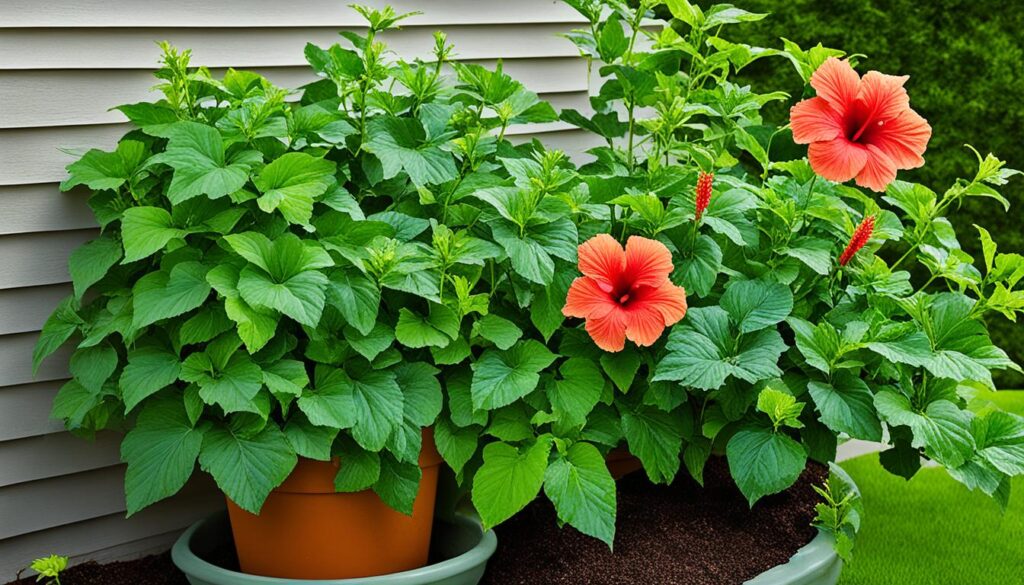
Whether you have hibiscus in containers or in your garden, understanding how to properly water and provide adequate sunlight is essential for their well-being and blooming success.
Extra Tips for Successful Hibiscus Care
Beyond the above-care tips, there are additional considerations that can help ensure successful hibiscus care. By keeping these factors in mind, you can maintain the health and beauty of your hibiscus plants for years to come.
Pest Prevention
Keeping an eye out for hibiscus pests is crucial for maintaining plant health. Common pests that affect hibiscus plants include aphids, spider mites, and whiteflies. Regularly inspect your plants for any signs of pest infestation, such as discolored leaves, sticky residue, or visible insects. If pests are detected, promptly take action to control and eradicate them using appropriate organic or chemical pest control methods.
Pruning for Bloom Promotion
Pruning hibiscus plants in early spring can help promote future blooms and remove weak or damaged branches. Use clean and sharp pruning shears to carefully trim back any overgrown or leggy branches. Focus on removing dead or diseased wood and shaping the plant to maintain a compact and balanced form. By pruning regularly, you can encourage healthy growth and vibrant flower production.
Yellow Leaves and Watering Adjustment
If you notice yellowing leaves on your hibiscus plants, it may be an indication of overwatering. Adjusting your watering practices can help rectify this issue. Before watering, check the moisture level of the soil by inserting your finger into the top inch of the soil. If it feels moist, hold off on watering until the soil has dried out slightly. By allowing the soil to dry between waterings, you can prevent the risk of overwatering and maintain optimal moisture levels for your hibiscus plants.
Caution When Using Clay Pots
When selecting pots for your hibiscus plants, it is advisable to avoid using clay pots. Over time, clay pots can affect the soil’s pH balance, potentially causing nutrient deficiencies or imbalances. Instead, opt for plastic or stone pots that provide better insulation and moisture retention. These types of pots offer a more stable growing environment for your hibiscus plants and can prevent potential issues associated with using clay pots.
By incorporating these extra tips into your hibiscus care routine, you can ensure the long-term health and beauty of your plants. Remember to stay vigilant against pests, prune regularly, adjust watering practices when necessary, and choose the right pots for optimal growth. With proper care, your hibiscus plants will thrive and reward you with stunning blooms.
Conclusion
California hibiscus care is a rewarding endeavor that allows gardeners to create vibrant and drought-tolerant landscapes. By paying attention to crucial factors such as soil selection, watering practices, and sunlight exposure, hibiscus plants can thrive in the Golden State. Understanding the unique requirements of different hibiscus varieties further enhances the gardening experience.
To ensure successful hibiscus care, gardeners in California should be observant and patient, adapting their care methods to the individual needs of their plants. By following essential care tips and exploring the stunning range of hibiscus varieties available, they can create incredible displays of color and texture in their gardens.
So, if you’re looking to add beauty to your California garden while conserving water, consider the diverse and drought-tolerant hibiscus plants. With proper care, these striking flowers will flourish and bring joy year after year. Start your hibiscus gardening journey today and unlock the true potential of your California landscape.

